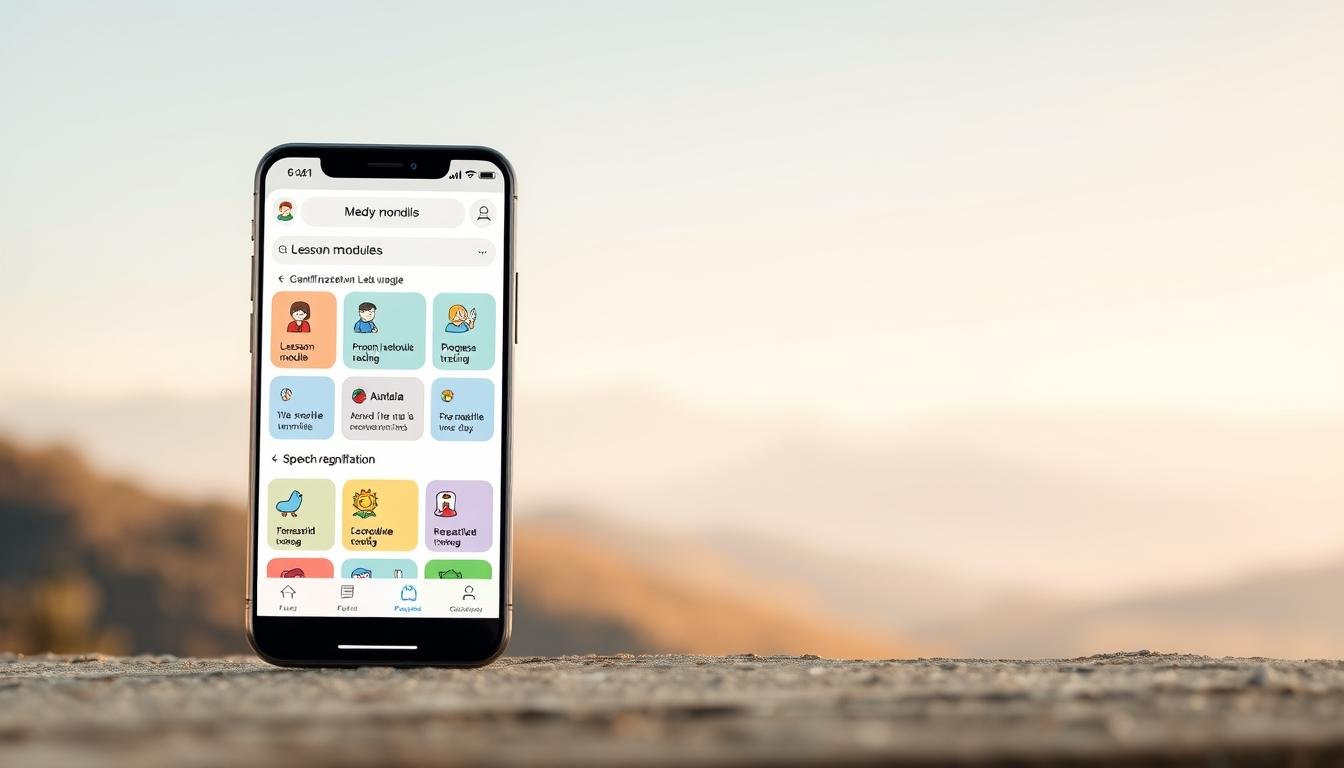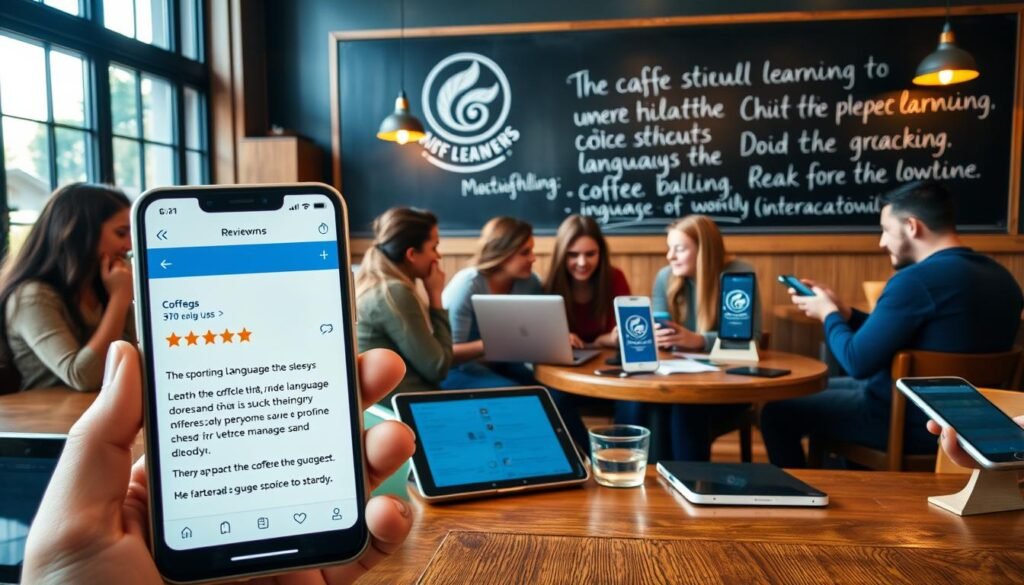Ever wondered why some people master new languages faster than others? The secret often lies in the effective methods they use. With the right tool, learning a language becomes engaging and efficient.
Founded in 2013 and now backed by Pearson, Mondly offers courses in 41 languages—including rare options like Latin. Its content is structured around the Global Scale of English, ensuring structured progress.
What sets this app apart? It blends AI-powered chatbots with a human-centric approach. The result? A dynamic way to learn new vocabulary and grammar naturally.
Key Takeaways
- Mondly provides structured language learning in 41 languages.
- Lessons align with the Global Scale of English for measurable progress.
- Uses AI chatbots to simulate real conversations.
- Backed by Pearson’s educational expertise.
- Offers rare language options like Latin and Tagalog.
Introduction to Mondly
Innovation has reshaped how we learn languages today. This language learning platform started as a basic app but quickly integrated cutting-edge tools. In 2016, it became the first to launch a chatbot with speech recognition, revolutionizing conversational practice.
The program expanded its tech with VR lessons in 2017 and AR in 2018. Users could interact with 3D objects, making education immersive. These features set a new standard for digital learning.
Pearson’s acquisition boosted its global reach, aligning with their education expertise. By 2020, the platform grew from 33 to 41 languages, including rare options like Latin.
Industry leaders took notice. Mondly won the 2021 WITSA Chairman’s Award and earned spots in Gartner reports. Its blend of AI and interactive tools offers a dynamic way learn languages effectively.
Key Features of Mondly
Language learning becomes effortless when technology meets structured education. This platform combines cutting-edge tools with practical lessons, ensuring progress fits into any schedule.
Daily Lessons and Structured Courses
Short, focused lessons make it easy to grasp a new language without overwhelm. Bite-sized content covers vocabulary, grammar, and culture in 5–10 minute sessions.
Courses follow the Global Scale of English, tracking progress like a personal tutor. Offline access lets users practice anywhere—no Wi-Fi needed.
Speech Recognition and Chatbot Technology
AI-powered chatbots simulate real conversations, correcting pronunciation in real time. The speech recognition system adapts to accents, building confidence for real-world interactions.
Podcast-style cultural lessons add context, turning phrases into meaningful dialogue.
Hands-Free Learning
A dynamic way learn on the go, driving mode uses voice commands for safety. Gesture controls and smart speaker integration let users practice while cooking or commuting.
Sync progress across devices seamlessly, picking up where you left off on any screen.
Advanced Learning Technologies
Cutting-edge tech now brings language lessons to life in 3D. This learning platform leverages VR and AR to create immersive experiences. Users don’t just memorize words—they interact with them.
Virtual Reality Language Learning
A 3D teacher avatar guides users through conversational drills. Projects like kitchen scenes let learners name objects in real time. Studies show VR boosts retention by 40% compared to traditional methods.
Launched in 2017, this feature turns headsets into classrooms. Users practice ordering food or asking directions in simulated cafes. It’s ideal for visual learners who thrive in interactive spaces.
Augmented Reality for Interactive Lessons
Augmented reality overlays lessons onto your surroundings. Point your phone at a table, and conjugation charts appear. The system recognizes 200+ objects, turning your home into a vocabulary lab.
ZDNet praised its 2018 launch for blending digital and physical worlds. Try a British English podcast while AR highlights London landmarks. Currently iOS-only, but Android support is planned.
Teachers use AR to explain grammar spatially. Verbs “float” above objects, linking form to function. Early data shows 30% higher engagement in AR mode.
Languages and Course Offerings
From Afrikaans to Urdu, the course offerings span the globe. With 41 languages, learners access everything from common tongues to rare gems like Latin and Persian.
Eight English variants cater to regional nuances. American English, British, and Australian options help learners adapt accents and slang. Over 1,320 language pairs let users learn languages from their native tongue.
Rare options like Bengali appeal to heritage learners. Families reconnect with roots through structured lessons. However, indigenous languages remain absent from the catalog.
Course depth varies. English boasts 50+ categories, while smaller languages focus on essentials. This ensures quality without overwhelming beginners.
User Experience and Reviews
User feedback reveals what works—and what doesn’t—in digital language education. The Mondly app earns praise for immersive tech but faces critiques on specific learning gaps. Over 10 million downloads showcase its popularity, yet detailed reviews uncover nuanced experiences.
What Users Love
Conversational AI receives consistent acclaim. The chatbot’s ability to simulate real dialogues helps learners build speaking confidence quickly. Many report improved pronunciation after just two weeks.
Structured progression through the program makes goals feel achievable. Daily streaks and visual progress trackers motivate consistent practice. Offline access ranks as a top feature for commuters.
The website dashboard provides clearer analytics than mobile versions. Users appreciate seeing which skills need reinforcement through color-coded skill maps.
Where Improvement Needed
Tonal languages like Thai expose chatbot limitations. The AI struggles with pitch-sensitive pronouns, sometimes causing awkward errors. Mandarin learners note similar issues with homophones.
Translation inaccuracies surface occasionally, especially with idiomatic phrases. While rare, these can reinforce incorrect usage if undetected.
Free content feels restrictive compared to competitors. Key features like AR lessons require subscription, unlike some rival programs.
Writing practice remains underdeveloped. The app focuses on speaking/listening, leaving composition skills to external tools.
Android updates lag behind iOS releases. Some VR features arrived 11 months later on Google’s platform, frustrating users.
Pricing and Subscription Options
Flexible pricing makes mastering new languages accessible for every budget. The platform offers tiered plans, starting at $9.99/month or $47.99/year—a 60% savings for annual commitments. A 7-day free trial lets users test features risk-free.
Compared to rivals like Babbel ($13.95/month) or Duolingo Premium ($12.99/month), this subscription delivers competitive value. Family plans cover up to six members, ideal for households learning new languages together.
Enterprise licensing caters to schools and businesses, with bulk discounts. Pearson employees enjoy exclusive rates, aligning with the company’s education partnerships. Refunds are available within 14 days if unsatisfied.
Polyglots benefit from unlimited language access under one subscription. Weekly quizzes and monthly challenges keep learners engaged, earning badges for milestones. Cancellation is hassle-free via the website dashboard.
For those prioritizing conversation practice, the subscription includes all VR/AR tools. It’s a cost-effective way to dive into immersive lessons without hidden fees.
Conclusion
Mastering a new language becomes achievable with the right language learning tool. This platform stands out with its effective methods, blending virtual reality and AI for immersive practice. Over 86% of users report feeling ready for real-world conversations.
Business learners gain confidence, with 84% improving fluency. The 2024 DISQ award confirms its status as a top learning portal. However, advanced students may need supplemental resources for complex grammar.
For most, it’s a powerful way to learn new vocabulary naturally. Future updates promise smarter AI tutors, making lessons even more personalized. Pair it with real-world practice for best results.
FAQ
How does Mondly help with learning a new language?
The platform uses structured lessons, speech recognition, and chatbot technology to improve vocabulary, grammar, and conversational skills. Daily exercises keep learning consistent.
What makes Mondly different from other language apps?
It offers advanced features like VR and AR for immersive learning. Hands-free mode and real-life conversation simulations enhance practical skills.
Can I use Mondly without a subscription?
Yes, there’s a free version with limited content. A paid subscription unlocks full access to courses, quizzes, and advanced features.
Does Mondly support learning multiple languages at once?
Yes, users can switch between languages anytime. The app tracks progress separately for each language.
Is Mondly suitable for beginners?
Absolutely. Courses start with basic vocabulary and gradually increase in difficulty, making it ideal for all skill levels.
How effective is the speech recognition feature?
It provides instant feedback on pronunciation, helping learners refine their accent and fluency through practice.
Are the lessons in Mondly interactive?
Yes, interactive chatbots and scenario-based exercises simulate real conversations for practical learning.
What languages are available on Mondly?
The app offers over 40 languages, including Spanish, French, German, Japanese, and more.
Can I track my progress with Mondly?
Yes, the app provides weekly quizzes, monthly challenges, and detailed stats to monitor improvement.
Does Mondly work offline?
Some features are available offline, but full functionality requires an internet connection.










